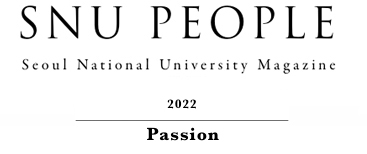Interview
Footprint of a living creature
that will be remembered forever
Seoul Grand Park Taxidermist
Jina Yoon(Department of Sculpture)
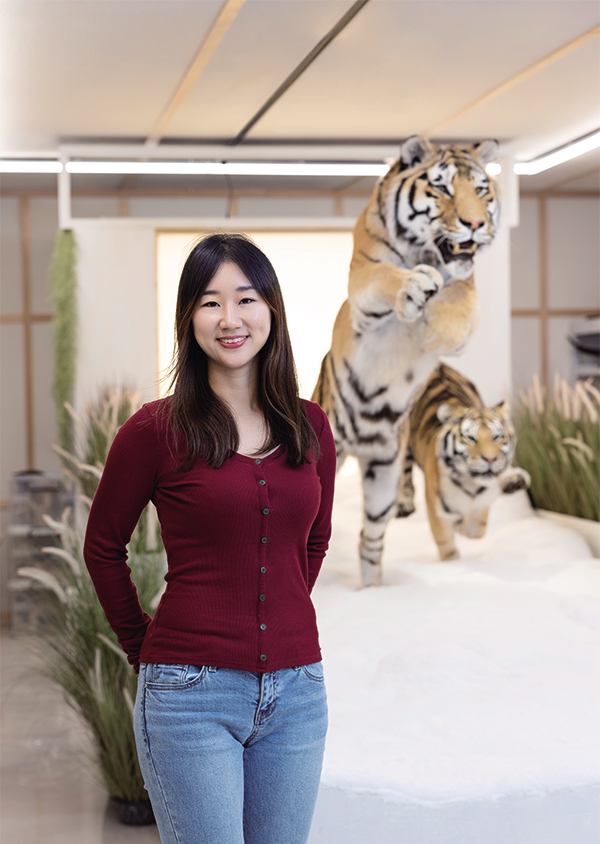
What is not recorded disappears. No living creature can escape this fact. Taxidermist Jina Yoon stuffs animals who have faced death at the zoo to create permanent records of their lives. Some call it an occupation consumed by death, but for Jina Yoon, the work of remembering the past of the deceased animal and expressing the beauty of it is not an end but the beginning of a second life.
Capturing the lifelike moment
Two tigers are running on the snow, hunting their prey. The sharp claws on the front of the tigerвҖҷs stretched-out paws stand out, looking as if they could touch your cheeks. Another tiger following behind is preparing itself for a leap. The two tigers captured here are Siberian tigers вҖңKoaвҖқ and вҖңHanwoolвҖқ that died in 2016 and 2018 at Seoul Grand Park. Taxidermist Jina Yoon gave new life to the two tigers that had been asleep in the freezer for years after one year of work. Ms. Yoon, with 13 years of experience as a taxidermist, has been working at the Zoological Specimen Manufacturing Office at Seoul Grand Park since 2015. There are only 20 people who are working as taxidermists in Korea, while fewer than 10 of those are working at a public organization, including Ms. Yoon. Ms. Yoon is the only taxidermist in Korea who works at a zoo instead of a museum.
вҖңTaxidermy is often negatively viewed as poachersвҖҷ war trophies. However, Seoul Grand Park only stuffs animals that died of natural causes, of illness or old age, for the purposes of exhibition, education, and research. When we display endangered species as specimens, people can closely observe wild animals that are difficult to see, and in hundreds of years, if an animal becomes extinct, the remaining specimen can be used as data for research. The animal does not disappear after its death but serves a new role as a living resource.вҖқ
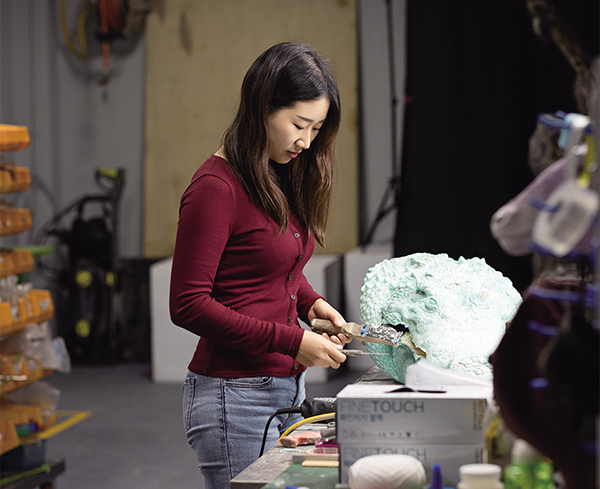
Working with the mannequin
For stuffing, you first freeze the dead animal and defrost it before manufacturing. Generally, after the Gyendo process, where the animalвҖҷs abdomen is cut to be skinned and to remove the meat and fat, the skin is made soft and flexible through chemical processing. Afterward, the prepared skin is mounted on the mannequin, and here, the mannequin should be manufactured to fit the shape and size of the former living entity anatomically. The eyes, nose, mouth, ears, and feet are expressed with details and sewn up to be dried for a few weeks afterward. Then, the water the skin absorbed completely evaporates, fading the color, which then requires new coloring.
вҖңStuffing requires various tasks, such as cutting, skin processing, carpentry, welding, coloring, carving, and casting. In addition, since there is no set method, the materials and the methods of stuffing vary depending on the type of living creature and the posture chosen by the taxidermist. The taxidermist has to discover the best method on his/her own. The process is difficult but entertaining at the same time since you create your own knowledge. In addition, since you can never create a perfectly taxidermied animal even if you try to make it look as close as possible to its natural look, it is an occupation requiring constant studying.вҖқ
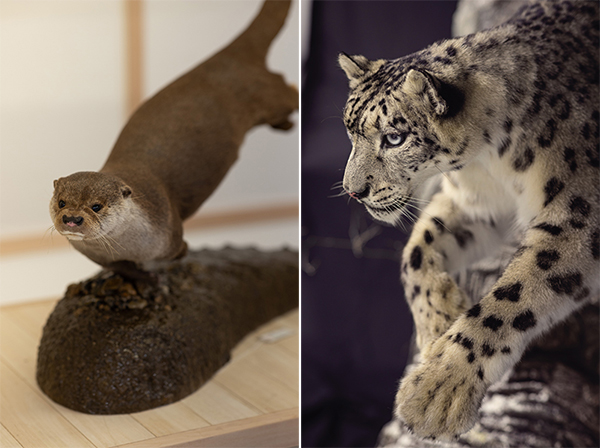
A stuffed specimen of a natural monument otter(left) an endangered species(right)
Meeting of science and art
Ms. Yoon determined her career early on, as she started studying the arts in elementary school. However, she always dreamed of вҖңa job working with animals.вҖқ Even after joining the Department of Sculpture, she continued questioning her career and often visited the Zootomy Research Lab at the Veterinary School. At the school, she first learned about taxidermy by encountering a skeletal specimen. To Ms. Yoon, who always enjoyed observing animals, the work of expressing the appearances of animals and the forms of muscles was natural, and her strong art skills gave her a confidence that she could do the job well.
вҖңI once assisted as a student intern at the Zootomy Research Lab at the Veterinary School. I dissected and studied the elks and racoons that were killed on roads as well as learned the methods of preservation by making skeleton specimens. After I encountered the skeleton specimen, I often visited the Natural History Museum, and around that time, I naturally became interested in taxidermy. I stayed in touch with Professor Kimura Junpei, who directed me back then, and currently, the students at the Veterinary School visit the Zoological Specimen Manufacturing Office for on-site study, and I also deliver special lectures at the Veterinary School.вҖқ
After graduation, Ms. Yoon worked at the National Institute of Biological Resources and learned stuffing. She acquired her Cultural Heritage Repair Technician certificate, enabling her to perform advanced stuffing and create specimens, and attended Bill AllenвҖҷs Pocono Institute of Taxidermy in the United States. However, her ability to create lively specimens of mammals with only domestic data was limited. Thus, she decided to seek advice from Canadian taxidermy champion Ken Walker through SNS. He recognized Ms. YoonвҖҷs skills and passion and imparted his knowledge on the taxidermy of mammals.
вҖңAfter meeting Mr. Walker, my ability to record the movements of animals developed further. In addition, since he introduced me to the global stage and complimented me, I was able to give a seminar at the European Taxidermy Championships that took place last year. I still communicate with him and receive help whenever I face difficulties.вҖқ
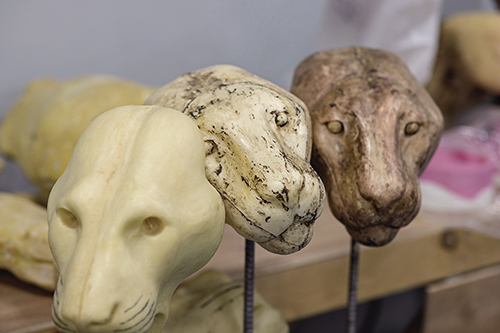
The mannequin that is covered with the skin should be manufactured to fit the shape and size of the former living entity
Work focused on life, not death
Prejudice followed, as it is a rare occupation. Some even asked why Ms. Yoon would do such cruel and repulsive work. Ms. Yoon says that she still feels sad when she hears people say that her work is harmful to animals, but she thinks that it is her calling to inform others of the roles and value of specimens. This is because she hopes that future taxidermy students will be able to work in a welcoming environment.
вҖңI experienced many inspiring moments when observing all the parts of the animals. When lifting the heavy paws of the tigers, I was mesmerized by the massiveness of the animals, and when I touched the hands of an orangutan, I remember I kept touching them for a while since the texture was so similar to that of human hands and they felt like the hands of an old man. Sometimes, I feel warmth in the deceased animalsвҖҷ bodies. When I give the dead animals new life with my hands and my long hours of dedicated work, they feel like my own kids, and I feel proud. Further, the idea that the specimen will remain in the world forever, even after my death, makes me realize the importance of doing a good job.вҖқ
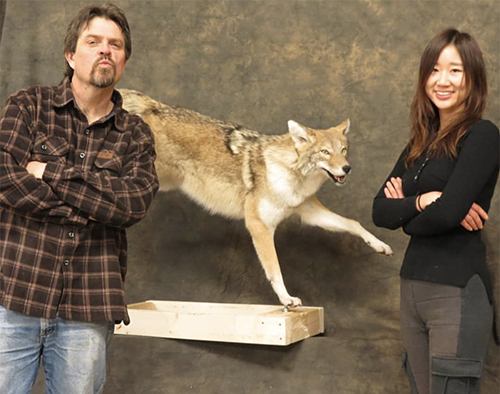
Taxidermy of coyote in collaboration with Canadian taxidermist champion Ken Walker
Ms. Yoon, who is currently preparing to stuff a Siamese crocodile, dreams of recovering the extinct saber-toothed cat from the Cenozoic period someday. She is also planning to create mannequins of native Korean animals, such as elks, sables,
wildcats, and otters, with 3D modeling so that future taxidermists can work in a better working environment. In this way, her dreams and passion for taxidermy will continue on for future generations, just like her newborn specimens.
вҖңMany people associate taxidermy with вҖҳdeath,вҖҷ but taxidermists work by looking at вҖҳlife,вҖҷ not death. Taxidermists are mesmerized by the life force and beauty of animals and strive to find various ways to perfectly recreate them. I hope the specimens I create become records of real life that cannot be replaced with photos or videos so that they become the steppingstone for the study of future scientists in Korea. We appreciate your interest and support in creating and preserving specimens.вҖқ
